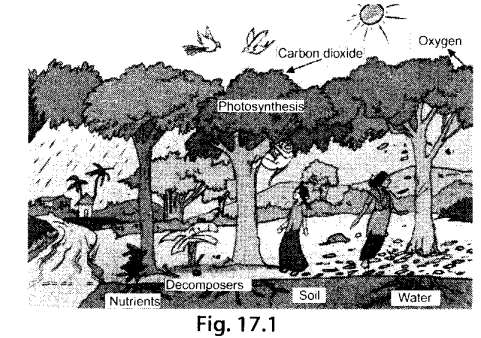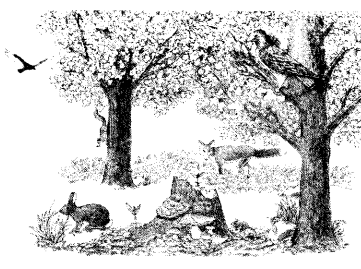NCERT Exemplar Class 7 Science Chapter 17 Forests Our Lifeline are part of NCERT Exemplar Class 7 Science. Here we have given NCERT Exemplar Class 7 Science Solutions Chapter 17 Forests Our Lifeline.
NCERT Exemplar Class 7 Science Solutions Chapter 17 Forests Our Lifeline
Multiple Choice Questions
Question 1.
Which of the following serve as green lungs?
(a) Green pigment of the plants
(b) Forests
(c) Kitchen gardens
(d) Greenhouse gases
Solution:
(b) Plants in the forest release oxygen during photosynthesis. This provides oxygen to all animals and helps to maintain the ratio of oxygen to carbon dioxide in the atmosphere.
Question 2.
Boojho visited a forest near his town with his classmates and his teacher. As they were entering the forest, their class teacher told them not to make noise in the forest as noise could disturb
(a) birds
(b) animals
(c) both birds and animals
(d) plants.
Solution:
(c)
Question 3.
Which among the following forest animals is the smallest?
(a) Fox
(b) Boar
(c) Bison
(d) Porcupine
Solution:
(d)
Question 4.
Which of the following has the strongest stem?
(a) A tree
(b) A creeper
(c) A climber
(d) A bush
Solution:
(a)
Question 5.
Which of the following is not prepared from the wood obtained from forest?
(a) Paper
(b) Thermocol
(c) Matchsticks
(d) Plywood
Solution:
(b)
Question 6.
Which of the following is not the name of a tree?
(a) Teak
(b) Sal
(c) Porcupine
(d) Kachnar
Solution:
(c) Teak, sal and kachnar are the names of trees whereas porcupine is an animal.
Question 7.
Pick the option which gives the names of a tree and an animal, respectively from the following.
(a) Semal, hornbill
(b) Sal, khair
(c) Chinkara, blue bull
(d) Neem, palash
Solution:
(a) Semal is the name of a tree and hornbill is the name of an animal.
Question 8.
Which of thefollowing products is not obtained from a forest?
(a) Honey
(b) Catechu
(c) Gum
(d) Ginger
Solution:
(d) Ginger is not found commonly in forests. It is a small plant which can be easily cultivated in crop fields.
Question 9.
The branchy part of a tree above the stem is known as
(a) crown
(b) canopy
(c) sapling
(d) humus.
Solution:
(a) The branchy part of a tree above stem is known as crown.
Question 10.
Forests are not responsible for
(a) providing medicinal plants
(b) maintaining the flow of water into the streams
(c) creating flood conditions
(d) absorbing rainwater and maintaining water table.
Solution:
(c) Forests prevent flooding. In a forest, raindrops do not hit the forest floor directly. The canopy layer of the forest intercepts the flow of raindrops so that rainwater falls on the leaves of trees and then drips slowly onto the forest floor. Thus, water does not collect and stagnate on the forest floor.
Very Short Answer Type Questions
Question 11.
Paheli while moving in a forest observed that there was no noise pollution, though lots of heavy vehicles were passing from the nearby highway. Explain why?
Solution:
Trees in the forest absorb sound of the nearby areas and help to reduce noise pollution. Hence, Paheli while moving in a forest did not feel noise of heavy vehicles passing from the nearby highway.
Question 12.
State whether the following statements are true or false. If false, give the correct statement.
(a) Forests influence climate, water cycle and air quality.
(b) In a forest, trees form the uppermost layer, followed by herbs. The shrubs form the lowest layer of vegetation.
(c) The forest keeps on growing and changing and can regenerate.
(d) Forests protect the soil from erosion.
Solution:
(a) True
(b) False: In a forest trees form the uppermost layer, followed by shrubs. Herbs form the lowest layer of vegetation.
(c) True
(d) True
Question 13.
Paheli wrote a food chain in the following way:
frog →eagle →insects → grass →snake
The chain is not in the correct order. Help her to write the food chain correctly.
Solution:
The correct food chain is as follows :
Grass →insects →frog → snake → eagle
Short Answer Type Questions
Question 14.
Give names of any four birds which you expect to see in a forest.
Solution:
Jungle crow, myna, kingfisher, koel, hornbill, etc.
Question 15.
Two friends shared their experiences of their vacation trip to two different forests. Do you think they would have seen the same type of plants and animals during their respective trips? Give reason.
Solution:
No, they would not have seen the same type of plants and animals. This is so because climatic conditions in the two forests would vary leading to variation in the tvpes of plants and animals found there.
Question 16.
“A bunch of seedlings were seen sprouting on a heap of animal dropping in a forest.” How do you think is the seedling benefited from the animal dung?
Solution:
Seeds sprout or germinate only in the presence of moisture. Seeds present on animal dung germinated because they received adequate moisture from animal dung. Further growth of seedling is supported bv the nutrients provided bv the animal dung.
Question 17.
Match column I with column II.
| Column 1 | Column II | ||
| (a) | Decomposers | (i) | Dead plant and animal tissues |
| (b) | Canopy | (ii) | Habitat for wild life |
| (c) | Porcupine | (iii) | Microorganisms |
| (d) | Humus | (iv) | Wild animal |
| (e) | Forest | (v) | Branches of tall trees |
Solution:
(a) (iii)
(b) (v)
(c) (iv)
(d) (i)
(e) (ii)
Question 18.
Deforestation may lead to floods. Why?
Solution:
In a forest, raindrops do not hit the forest floor directly. The canopy layer of the forest intercepts the flow of raindrops so that rainwater falls on the leaves of trees and then drips slowly onto the forest floor. Thus, water does not collect and stagnate on the forest floor. This prevents flooding. Deforestation is the destruction of forests or large scale cutting of trees on a land. In the absence of trees, the flow of water is disrupted which may lead to floods.
Question 19.
Name any four useful products other than wood, which we get from forests.
Solution:
Forests yield many valuable products other than wood such as turpentine, latex, oil, spices, resins, gum etc.
Long Answer Type Questions
Question 20.
Figure 17.1 shows a part of a forest.

Write any three activities going on in the forest on the basis of this figure.
Solution:
Based on the given picture of forest, following activities are going on :
(i) Carbon dioxide is consumed by the plants in the process of photosynthesis.
(ii) Oxygen is given out by the plants during photosynthesis.
(iii) Decomposers are decomposing organic matter present on the forest floor and enriching the soil with nutrients which are taken up by plants for growth.
Question 21.
People say that nothing goes waste in a forest. Can you explain, how?
Solution:
Forests work as a self-sustaining system in nature. Whatever is produced in the forest is utilised by different components of the forest and is naturally recycled. All animals (whether herbivores, carnivores or omnivores) depend ultimately on plants for food. Herbivores eat plants. Carnivores eat herbivores. Omnivores eat both plants and animals. When plants and animals die, their dead remains are decomposed by microorganisms (bacteria and fungi) into nutrients, which are released back into soil. From the soil, these nutrients are absorbed by the roots of living plants. This is called as recycling of nutrients due to which nothing goes waste in a forest.
Question 22.
Give any four factors which are responsible for the destruction of forests.
Solution:
Deforestation is the destruction of forests or large scale cutting of trees on a land. The growing human population has been the primary cause of forest destruction. Humans clear forests for the following purposes :
(i) Construction of roads
(ii) Construction of buildings
(iii) Industrial development
(iv) For agricultural purposes to meet the increasing demand of food
There are also some natural causes of deforestation viz. forest fire occurring due to lightning during a storm or by friction between dry branches of trees.
Question 23.
Draw a figure showing two animals, two birds and a few trees as a part of a forest.
Solution:
The given picture shows animals like rabbit, fox, squirrel and birds like eagle and red-tailed hawk along with few trees in a forest patch.

Question 24.
All the needs of animals living in a forest are fulfilled. Justify this statement in a few sentences.
Solution:
Plants and animals in a forest show interdependence. Plants present in the forest fulfill all the needs of animals present there. Plants provide 02 to the animals to respire. They also provide food to all the animals directly or indirectly. Herbivores obtain food directly from plants, carnivores depend on herbivores for food. Trees in forest provide shelter to forest animals. Hence, we can say that all the needs of animals in a forest are fulfilled.
Question 25.
“Forests are our lifeline.” Write five sentences on this topic.
Solution:
Forests are very important renewable natural resource. They are useful in the following ways :
(i) Plants in forest purify air by absorbing C02 and releasing 02 and also maintain a balance between 02 and C02 in the atmosphere.
(ii) Plants in the forest absorb water from the soil through their roots and release it into the air by the process of transpiration which increases the amount of water vapour in the air, helps in cloud formation and rainfall. Thus, forests play an important role in water cycle operating on the earth.
(iii) Forests provide us various products such as wood, gum, medicines fruits, latex, etc.
(iv) The roots of trees in forest bind the soil particles together which helps in preventing soil erosion. Moreover, the raindrops do not fall directly on the forest floor with full force due to presence of plants in different layers in a forest which prevents flooding.
(v) Forests help in maintaining the water table by harvesting the rainwater.
NCERT Exemplar Class 7 Science Solutions
- Chapter 1 Nutrition in Plants
- Chapter 2 Nutrition in Animals
- Chapter 3 Fibre to Fabric
- Chapter 4 Heat
- Chapter 5 Acids, Bases and Salts
- Chapter 6 Physical and Chemical Changes
- Chapter 7 Weather, Climate and Adaptations of Animals to Climate
- Chapter 8 Winds, Storms and Cyclones
- Chapter 9 Soil
- Chapter 10 Respiration in Organisms
- Chapter 11 Transportation in Animals and Plants
- Chapter 12 Reproduction in Plants
- Chapter 13 Motion and Time
- Chapter 14 Electric Current and Its Effects
- Chapter 15 Light
- Chapter 16 Water: A Precious Resource
- Chapter 17 Forests: Our Lifeline
- Chapter 18 Wastewater Story
We hope the NCERT Exemplar Class 7 Science Chapter 17 Forests Our Lifeline will help you. If you have any query regarding NCERT Exemplar Class 7 Science Solutions Chapter 17 Forests Our Lifeline, drop a comment below and we will get back to you at the earliest.